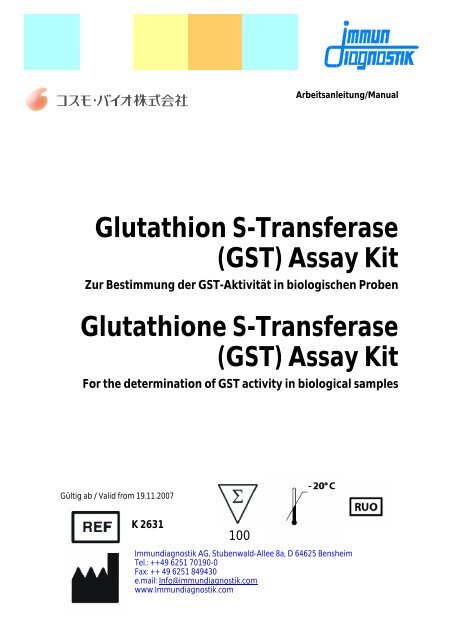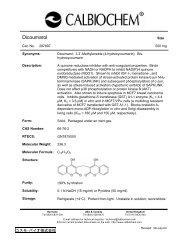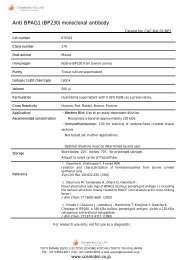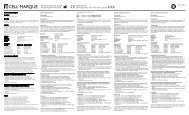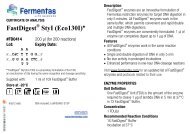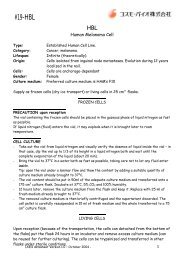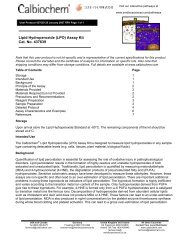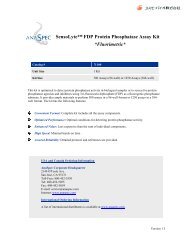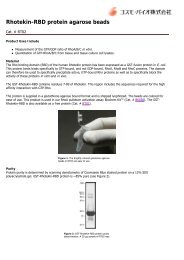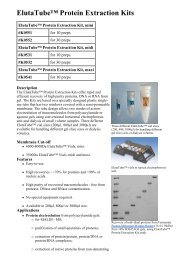Glutathion S-Transferase
Glutathion S-Transferase
Glutathion S-Transferase
Create successful ePaper yourself
Turn your PDF publications into a flip-book with our unique Google optimized e-Paper software.
Arbeitsanleitung/Manual<br />
<strong>Glutathion</strong> S-<strong>Transferase</strong><br />
(GST) Assay Kit<br />
Zur Bestimmung der GST-Aktivität in biologischen Proben<br />
<strong>Glutathion</strong>e S-<strong>Transferase</strong><br />
(GST) Assay Kit<br />
For the determination of GST activity in biological samples<br />
Gültig ab / Valid from 19.11.2007<br />
K 2631<br />
100<br />
Immundiagnostik AG, Stubenwald-Allee 8a, D 64625 Bensheim<br />
Tel.: ++49 6251 70190-0<br />
Fax: ++ 49 6251 849430<br />
e.mail: Info@immundiagnostik.com<br />
www.Immundiagnostik.com
Arbeitsanleitung/Manual<br />
GST – Aktivität/Activity<br />
Inhalt / Content<br />
1. Deutsch<br />
2. English<br />
Weitere Informationen zu unseren Produkten finden Sie auf unserer<br />
Homepage<br />
Additional information about our products is available on our homepage<br />
www.immundiagnostik.com
Arbeitsanleitung/Manual<br />
GST – Aktivität/Activity<br />
1. VERWENDUNGSZWECK<br />
Der <strong>Glutathion</strong> S-<strong>Transferase</strong> (GST) Assay Kit ist für die Bestimmung der<br />
Gesamt-GST Aktivität in Zell- und bakteriellen Lysaten, Gewebehomogenisaten<br />
und in Erythrocyten-Lysaten geeignet. Nur für Forschungszwecke.<br />
2. EINLEITUNG<br />
Die Enzymfamilie der <strong>Glutathion</strong>–S–<strong>Transferase</strong>n (GST) spielt eine<br />
entscheidende Rolle in der Entgiftung von Xenobiotika. GST katalysiert die<br />
Übertragung der Thiolgruppe des <strong>Glutathion</strong> auf eletrophile Moleküle.<br />
Dabei wird die Ausscheidungsfähigkeit verschiedener Substanzen durch<br />
Überführung in hydrophilere Metaboliten erhöht. Die Enzyme fungieren<br />
somit als ein Teil des Abwehrmechanismus gegen mutagene, kanzerogene<br />
und toxische Effekte solcher Verbindungen.<br />
Der GST–Aktivitäts-Test basiert auf der GST-katalysierten Reaktion zwischen<br />
GSH und dem GST Substrat, CDNB (1-Chloro-2,4-dinitrobenzol), zum<br />
entsprechenden Thioether-Konjugat. Die Konjugatbildung ist proportional<br />
zur Enzymaktivität und kann zur photometrischen Aktivitätsbestimmung der<br />
GST herangezogen werden, indem die Bildung des Konjugates beim<br />
Absorptionsmaxium von 340 nm kinetisch verfolgt wird.<br />
Indikation<br />
• Detoxifikationsmarker<br />
3. TESTPRINZIP<br />
Die GST katalysiert die Bindung von L-<strong>Glutathion</strong> an CDNB über die<br />
<strong>Glutathion</strong>-Thiolgruppe.<br />
GST<br />
GSH + CDNB →<br />
GS-DNB Konjugat + HCl<br />
Die GS-DNB-Konjugatbildung ist proportional zur Enzymaktivität und kann<br />
zur photometrischen Aktivitätsbestimmung der GST herangezogen werden,<br />
indem die Bildung des Konjugates beim Absorptionsmaxium von 340 nm<br />
kinetisch verfolgt wird.<br />
Eine Einheit der GST Aktivität ist definiert als die Menge, die das Enzym bei<br />
der Konjugation von 1 mmol GS-DNB pro Minute unter Testbedingungen<br />
produziert.<br />
1
Arbeitsanleitung/Manual<br />
GST – Aktivität/Activity<br />
4. INHALT DER TESTPACKUNG<br />
Artikel Nr. Inhalt Kit Komponenten Menge<br />
K 2631BU ASYBUF GST Assaypuffer 2 x 65 ml<br />
K 2631KO CTRL POS GST Positivkontrolle 10 x 1 vial<br />
K 2631SUB SOL A Substrat (CDNB) 10 x 120 µl<br />
K 2631GSH SOL B L-<strong>Glutathion</strong> reduziert 10 x 120 µl<br />
K 2631PV SAMPLEBUF Probenverdünnungspuffer 1 x 80 ml<br />
5. ERFORDERLICHE LABORGERÄTE UND HILFSMITTEL<br />
• Temperaturkontrolliertes UV/VIS-Spektrometer<br />
• 1 ml einmal- oder Quarz-Küvetten<br />
• Präzisionspipetten und Pipettenspitzen für den Einmalgebrauch mit<br />
variablen Volumina von 5 - 1000 µl<br />
• Multikanal- bzw. Multipipette<br />
• Bidestilliertes Wasser (aqua bidest.)<br />
• Laborübliche Glas- oder Einmalartikel, Plastikröhrchen (1,5 ml)<br />
• Zentrifuge, 14000 x g<br />
• Vortex-Mixer<br />
6. PROBENVORBEREITUNG<br />
Erythrozyten<br />
200 µl SAMPLEBUF (Probenverdünnungspuffer) zu 50 µl der zuvor<br />
eingefrorenen EDTA Vollblut-Probe oder zu der CTRL POS (Positivkontrolle)<br />
pipettieren, 10 sec vortexen.<br />
Anschließend 10 min bei 14000 x g, wenn möglich unter Kühlung<br />
zentrifugieren.<br />
Den Überstand abnehmen und für den Test einsetzen.<br />
Durch das Tieffrieren der Vollblutprobe und die anschließende Behandlung<br />
mit dem SAMPLEBUF (Probenpuffer) wird die vollständige Lyse der<br />
Erythrocytenzellen gewährleistet.<br />
2
Arbeitsanleitung/Manual<br />
GST – Aktivität/Activity<br />
7. VORBEREITUNG UND LAGERUNG DER REAGENZIEN<br />
• SOL A (Substrat), CTRL (Kontrolle) und SOL B (<strong>Glutathion</strong>) sind stabil bei<br />
-20 °C bis zum angegebenen Haltbarkeitsdatum.<br />
• ASYBUF (GST Assaypuffer) und SAMPLEBUF (Probenverdünnungspuffer)<br />
bei Raumtemperatur auftauen lassen.<br />
• SOL A (Substrat) und SOL B (<strong>Glutathion</strong>) unmittelbar vor dem Einsatz bei<br />
Raumtemperatur auftauen lassen.<br />
• Herstellung der Reaktionslösung ausreichend für 10 Messungen:<br />
ASYBUF<br />
9,8 ml<br />
SOL A<br />
0,1 ml<br />
SOL B<br />
0,1 ml<br />
Durch Zugabe des SOL A kann eine leichte Trübung auftreten, welche nach<br />
sorgfältiger Durchmischung der Lösung verschwindet.<br />
Wichtig: die Substratlösung muss für jede Messreihe frisch angesetzt<br />
werden. Sie kann maximal 60 Minuten in einem lichtgeschützten Gefäß<br />
aufbewahrt werden.<br />
8. TESTDURCHFÜHRUNG<br />
Pipettierschema<br />
Am Spektralphotometer 340 nm einstellen. Das Kinetikprogramm<br />
programmieren. Es wird empfohlen die Absorption ab der 1. Minute über 5<br />
Minuten zu messen; Zeit zwischen den Messzyklen: 30 Sekunden.<br />
Messung des Blanks: 1000 µl der Reaktionslösung in eine Küvette geben<br />
und auf 25 °C temperieren. Die Steigung [∆A 340 /min] zwischen Minute 1<br />
und Minute 5 erfassen.<br />
Messung der Proben: 995 µl der Reaktionslösung in eine Küvette geben<br />
und auf 25°C temperieren. 5 µl des vorbereiteten Probenlysats dazugeben<br />
und gut durchmischen. Die Steigung [∆A 340 /min] zwischen Minute 1 und<br />
Minute 5 erfassen.<br />
Es ist darauf zu achten, dass die Steigung der Absorption [∆A 340 /min]<br />
eine Gerade darstellt. In allen anderen Fällen muss die Probe mit<br />
SAMPLEBUF (Probenverdünnungspuffer) verdünnt und noch mal<br />
analysiert werden.<br />
3
Arbeitsanleitung/Manual<br />
GST – Aktivität/Activity<br />
9. ERGEBNISSE<br />
Auswertung<br />
Die Steigung [∆A 340 /min] ist direkt proportional zur GST Aktivität.<br />
Blank und Probe<br />
∆A 340nm /min = A 340nm (Stop) – A 340nm (Start)<br />
Reaktionszeit (min)<br />
Die ∆A 340nm /min des Blanks von der ∆A 340nm /min der Probe abziehen. Das<br />
Ergebnis zur Berechnung der GST – Aktivität heranziehen.<br />
GST spezifische Aktivität<br />
(∆A 340nm /min) * V (ml) * dil * = µmol/ml/min<br />
ε mM * V Probe (ml)<br />
ε mM (mM -1 cm -1 ) = Extinktionskoeffizient für das CDNB Konjugat bei 340 nm<br />
Küvettentest : 9,6 mM -1 (Schichtdicke 1 cm)<br />
Für eine Küvette mit einer davon abweichenden Schichtdicke<br />
gilt:<br />
ε mM = 9,6 * Schichtdicke in cm<br />
V = Reaktionsvolumen (1 ml)<br />
dil = Verdünnungsfaktor der Probe<br />
V Probe = Volumen der getesteten Probe (z.B. 0,005 ml)<br />
10. EINSCHRÄNKUNGEN<br />
Bei höheren Aktivitäten der GST Kontrolle oder GST Proben, Überstand mit<br />
SAMPLEBUF verdünnen und die Bestimmung wiederholen. Der Verdünnungsfaktor<br />
muss berücksichtigt werden.<br />
4
Arbeitsanleitung/Manual<br />
GST – Aktivität/Activity<br />
11. QUALITÄTSKONTROLLE<br />
Immundiagnostik AG empfiehlt den Einsatz von kommerziell erhältlichen<br />
Kontrollen (wenn vorhanden) für die interne Qualitätskontrolle.<br />
Wir empfehlen, die Kontrollen bei jedem Testansatz mitzumessen. Die<br />
Ergebnisse der Kontrollen müssen auf Richtigkeit überprüft werden. Liegen<br />
ein oder mehrere Werte außerhalb des angegebenen Bereiches, kann<br />
Immundiagnostik AG die Richtigkeit der Werte nicht gewährleisten.<br />
12. VORSICHTSMAßNAHMEN<br />
• Nur für Forschungszwecke.<br />
• Qualitätskontrollen sollten immer mit gemessen werden.<br />
• Das für Kitkomponenten verwendete humane Material wurde auf HIV,<br />
Hepatitis B und Hepatitis C getestet und für negativ befunden.<br />
Dennoch wird empfohlen, die Kitkomponenten als Vorsichtsmaßnahme<br />
immer wie potentiell infektiöses Material zu behandeln.<br />
• Die Kitkomponenten enthalten zum Schutz vor bakteriellen<br />
Kontaminationen Natriumazid oder Thimerosal. Natriumazid bzw.<br />
Thimerosal sind giftig. Auch Substrate für enzymatische Farbreaktionen<br />
sind giftig und karzinogen. Jeder Kontakt mit Haut oder Schleimhaut ist<br />
zu vermeiden.<br />
13. TECHNISCHE MERKMALE<br />
• Reagenzien der Kitpackung dürfen nicht mit anderen Chargen gemischt<br />
werden.<br />
• Reagenzien nach Ablauf des Mindesthaltbarkeitsdatums nicht mehr<br />
verwenden.<br />
• Substratlösung muss vor Gebrauch farblos sein.<br />
• Schaumbildung beim Mischen der Reagenzien vermeiden.<br />
• Bestimmung immer nach der im Kit beigefügten Arbeitsanleitung<br />
durchführen.<br />
5
Arbeitsanleitung/Manual<br />
GST – Aktivität/Activity<br />
14. ALLGEMEINE HINWEISE ZUM TEST<br />
• Alle im Kit enthaltenen Reagenzien dürfen ausschließlich für Forschungszwecke<br />
verwendet werden.<br />
• Für die Qualitätskontrolle sind die für medizinische Laboratorien<br />
erstellten Richtlinien zu beachten.<br />
• Die Testcharakteristika wie Inkubationszeiten, Inkubationstemperaturen<br />
und Pipettiervolumina der verschiedenen Komponenten wurden vom<br />
Hersteller festgelegt. Nicht mit dem Hersteller abgesprochene<br />
Veränderungen in der Testdurchführung können die Resultate<br />
beeinflussen. Die Firma Immundiagnostik AG übernimmt für die<br />
hierdurch entstandenen Schäden und Folgeschäden keine Haftung.<br />
• Bei Gewährleistungsansprüchen ist das beanstandete Material mit<br />
schriftlicher Erklärung innerhalb von 14 Tagen zum Hersteller, der<br />
Immundiagnostik AG, zurück zu senden.<br />
15. LITERATUR<br />
1. Mozer, T. J., et al., Purification and characterization of corn glutathione<br />
S-transferase. Biochemistry 22, 1068-1072 (1983).<br />
2. Toung, Y. P., et al., Drosophila glutathione S-transferase 1-1 shares a<br />
region of sequence homology with the maize glutathione-S-transferase<br />
III. Proc. Natl. Acad. Sci. USA, 87, 31-35 (1990).<br />
3. Tamaki, H., et al., Expression of two <strong>Glutathion</strong>e-S-<strong>Transferase</strong>genes in<br />
the yeast Issatchenkia orientalis is induced by o-dinitrobenzene during<br />
cell growth arrest. J. Bacteriol., 181, 2958-2962 (1999).<br />
4. Piccolomini, R., et al., <strong>Glutathion</strong>e transferase in bacteria: subunit<br />
composition and antigenic characterization. J. Gen. Microbiol., 135,<br />
3119- 3125 (1989).<br />
5. Habig, W. H., et al., <strong>Glutathion</strong>e S-transferase. The fist enzymatic step in<br />
mercapturic acid formation. J. Biol. Chem., 249, 7130-7139 (1974).<br />
6. Mannervik, B. and Danielson, U. H. <strong>Glutathion</strong>e transferases - structure<br />
and catalytic activity. CRC Crit. Rev. Biochem., 23, 283-337 (1988).<br />
7. Wilce, M. C. J., and Parker, M. W., Structure and function of <strong>Glutathion</strong>e<br />
S-<strong>Transferase</strong>s. Biochem. Biophys. Acta, 1205, 1-18 (1994).<br />
20.11.2007 26012005_GST.DOC<br />
6
Arbeitsanleitung/Manual<br />
GST – Aktivität/Activity<br />
7
Arbeitsanleitung/Manual<br />
GST – Aktivität/Activity<br />
Manual<br />
<strong>Glutathion</strong>e S-<strong>Transferase</strong><br />
(GST) Assay Kit<br />
For the determination of GST activity in biological samples<br />
Valid from 19.11.2007<br />
K 2631<br />
100<br />
8
Arbeitsanleitung/Manual<br />
GST – Aktivität/Activity<br />
1. INTENDED USE<br />
The <strong>Glutathion</strong>e S-<strong>Transferase</strong> (GST) Assay Kit is intended for the<br />
measurement of total GST activity. It can be used to measure GST activity in<br />
cell and bacterial lysates, tissue homogenates, and in erythrocyte lysates. It is<br />
for research use only.<br />
2. INTRODUCTION<br />
<strong>Glutathion</strong>e-S-transferases (GSTs) are a group of enzymes that are important<br />
in the detoxication of many different xenobiotics in mammals. The enzymes<br />
protect cells against toxicants by conjugating the thiol group of the<br />
glutathione to electrophilic xenobiotics, and thereby defend cells against<br />
the mutagenic, carcinogenic, and toxic effects of the compounds. GST<br />
activity was found to be present in plants, insects, yeast, bacteria, and in<br />
most mammalian tissues, especially in the liver, which plays a key role in<br />
detoxification. There are several classes of GST isoenzymes that differ in their<br />
specificity toward xenobiotic or endogenous substrates.<br />
The <strong>Glutathion</strong>e S-<strong>Transferase</strong> (GST) Assay Kit utilizes 1-Chloro-2,4-<br />
dinitrobenzene (CDNB) which is suitable for the broadest range of GST<br />
isoenzymes. Upon conjugation of the thiol group of glutathione to the<br />
CDNB substrate, there is an increase in the absorbance at 340 nm.<br />
Indication<br />
• Detoxification marker<br />
3. PRINCIPLE OF THE TEST<br />
GST catalyzes the conjugation of L-glutathione to CDNB through the thiol<br />
group of the glutathione.<br />
GST<br />
GSH + CDNB →<br />
GS-DNB Conjugate + HCl<br />
The formation of the GS-DNB conjugate is proportional to the enzyme<br />
activity and can be used for photometric GST activity determination. The<br />
rate of increase in the absorption at 340 is directly proportional to the GST<br />
activity in the sample.<br />
One unit of GST activity is defined as the amount of enzyme producing<br />
1 mmol of GS-DNB conjugate per minute under the conditions of the assay.<br />
9
Arbeitsanleitung/Manual<br />
GST – Aktivität/Activity<br />
4. MATERIAL SUPPLIED<br />
Catalogue No Content Kit Components Quantity<br />
K 2631BU ASYBUF GST Assay buffer 2 x 65 ml<br />
K 2631KO CTRL GST Positive control 10 x 1 vial<br />
K 2631SUB SOL A Substrate (CDNB) 10 x 120 µl<br />
K 2631GSH SOL B L-<strong>Glutathion</strong>e reduced 10 x 120 µl<br />
K 2631PV SAMPLEBUF Sample dilution buffer 1 x 80 ml<br />
5. MATERIAL REQUIRED BUT NOT SUPPLIED<br />
• Temperature controlled UV/visible spectrophotometer<br />
• 1 ml disposable cuvette or Quartz cuvette<br />
• Precision pipettors and disposable tips to deliver 5-1000 µl<br />
• A multi-channel dispenser or repeating dispenser<br />
• Bidistilled water<br />
• Standard laboratory glass or plastic vials, 1,5 ml<br />
• Centrifuge capable of 14000 x g<br />
• Vortex-Mixer<br />
6. SAMPLE PREPARATION<br />
Erythrocytes<br />
Add 200 µl SAMPLEBUF (Sample dilution buffer) to 50 µl of frozen EDTA<br />
whole blood sample or CTRL POS (positive control), vortex for 10 sec.<br />
Centrifuge at 14,000 x g for 10 minutes, if possible under cooling.<br />
Collect supernatant and use for the assay.<br />
The deep freezing of the whole blood sample und its subsequent treatment<br />
with the SAMPLEBUF (sample dilution buffer) ensures the complete lysis of<br />
the erythrocytes.<br />
10
Arbeitsanleitung/Manual<br />
GST – Aktivität/Activity<br />
7. PREPARATION AND STORAGE OF REAGENTS<br />
• SOL A (Substrate), CTRL (control) and SOL B (glutathione) are stable at<br />
-20 °C until the expiry date stated on the label.<br />
• Thaw ASYBUF (GST assay buffer) and SAMPLEBUF (sample dilution<br />
buffer) and bring to room temperature before use in the assay.<br />
• Thaw SOL A (substrate) and SOL B (glutathione) and bring to room<br />
temperature immediately before use in the assay.<br />
• Preparation of reaction mixture for 10 determinations:<br />
ASYBUF<br />
9,8 ml<br />
SOL A<br />
0,1 ml<br />
SOL B<br />
0,1 ml<br />
The addition of SOL A may cause a light turbidity, which disappears upon<br />
carefully mixing the solution.<br />
Note: the substrate solution must be prepared fresh before each assay<br />
series. It can be stored for maximal 60 minutes in a light protected vial.<br />
8. ASSAY PROCEDURE<br />
Test procedure<br />
Set the spectrophotometer at 340 nm. On a kinetic program: read every 30<br />
seconds over a period of 5 minutes after a lag time of 1 minute.<br />
Blank measurement: Transfer 1000 µl of the reaction mixture solution to a<br />
cuvette, wait until a temperature of 25 °C is achieved and maintain at that<br />
temperature. Read the increase in the absorption [∆A 340 /min] over a period<br />
of 5 minutes after a lag time of 1 minute.<br />
Sample measurement: Add 955 µl reaction mixture solution directly to<br />
the cuvette, wait until a temperature of 25 °C is achieved and maintain at<br />
that temperature. Add 5 µl of the pre-treated sample and mix well. Read<br />
the increase in the absorption [∆A 340 /min] over a period of 5 minutes after<br />
a lag time of 1 minute.<br />
Pay attention, that the increase in the absorption [∆A 340 /min] is linear.<br />
In all other cases, the sample must be diluted in SAMPLEBUF (sample<br />
dilution buffer) and re-assayed.<br />
11
Arbeitsanleitung/Manual<br />
GST – Aktivität/Activity<br />
9. RESULTS<br />
Calculations<br />
The increase in absorbance [∆A 340 /min] is directly proportional to the GST<br />
activity.<br />
Sample and blank<br />
∆A 340nm /min = A 340nm (Stop) – A 340nm (Start)<br />
Reaction time (min)<br />
Subtract the ∆A 340nm /min of the blank from the ∆A 340nm /min of the sample.<br />
Use this rate for the calculation of the GST specific activity.<br />
Equation for the GST specific activity<br />
(∆A 340nm /min) * V (ml) * dil * = µmol/ml/min<br />
ε mM * V sample (ml)<br />
Where:<br />
ε mM (mM -1 cm -1 ) = The extinction coefficient for CDNB conjugate at 340 nm<br />
For a cuvette: 9,6 mM -1 (path length 1 cm)<br />
For a cuvette with a different path length, the coefficient<br />
should be calculated using this substitution factor:<br />
ε mM = 9,6 * path length in cm<br />
V = the reaction volume (1 ml)<br />
dil = the dilution factor of the original sample<br />
V Sample = the volume of the enzyme sample tested (e.g. 0.005 ml)<br />
10. LIMITATIONS<br />
If the GST control or GST sample is too concentrated, it must be diluted with<br />
SAMPLEBUF prior to the assay. The dilution factor must be considered.<br />
12
Arbeitsanleitung/Manual<br />
GST – Aktivität/Activity<br />
11. QUALITY CONTROL<br />
Immundiagnostik AG recommends the use of commercial control samples<br />
for internal quality control if available.<br />
Control samples should be analyzed with each run. Results, generated from<br />
the analysis of control samples, should be evaluated for acceptability using<br />
appropriate statistical methods. The results for the patient samples may not<br />
be valid, if within the same assay one or more values of the quality control<br />
sample are outside the acceptable limits.<br />
12. PRECAUTIONS<br />
• For research use only.<br />
• Quality control guidelines should be observed.<br />
• Human materials used in kit components were tested and found to be<br />
negative for HIV, Hepatitis B and Hepatitis C. However, for safety reasons,<br />
all kit components should be treated as potentially infectious.<br />
• Kit reagents contain sodium azide or thimerosal as bactericides. Sodium<br />
azide and thimerosal are toxic. Substrates for the enzymatic color<br />
reactions are toxic and carcinogenic. Avoid contact with skin or mucous<br />
membranes.<br />
13.TECHNICAL HINTS<br />
• Do not interchange different lot numbers of any kit component within<br />
the same assay.<br />
• Reagents should not be used beyond the expiration date shown on the<br />
kit label.<br />
• Substrate solution should remain colorless until use.<br />
• Avoid foaming when mixing reagents.<br />
• The assay should always be performed according the enclosed manual.<br />
13
Arbeitsanleitung/Manual<br />
GST – Aktivität/Activity<br />
14. GENERAL NOTES ON THE TEST AND TEST PROCEDURE<br />
• All reagents in the kit package are for research use only.<br />
• Guidelines for medical laboratories should be observed.<br />
• Incubation time, incubation temperature and pipetting volumes of the<br />
components are defined by the producer. Any variation of the test<br />
procedure, which is not coordinated with the producer, may influence<br />
the results of the test. Immundiagnostik AG can therefore not be held<br />
responsible for any damage resulting from wrong use.<br />
• Warranty claims and complaints in respect of deficiencies must be<br />
logged within 14 days after receipt of the product. The product shall be<br />
send to Immundiagnostik AG along with a written complaint.<br />
15. REFERENCES<br />
1. Mozer, T. J., et al., Purification and characterization of corn glutathione S-<br />
transferase. Biochemistry 22, 1068-1072 (1983).<br />
2. Toung, Y. P., et al., Drosophila glutathione S-transferase 1-1 shares a<br />
region of sequence homology with the maize glutathione-S-transferase<br />
III. Proc. Natl. Acad. Sci. USA, 87, 31-35 (1990).<br />
3. Tamaki, H., et al., Expression of two <strong>Glutathion</strong>e-S-<strong>Transferase</strong>genes in<br />
the yeast Issatchenkia orientalis is induced by o-dinitrobenzene during<br />
cell growth arrest. J. Bacteriol., 181, 2958-2962 (1999).<br />
4. Piccolomini, R., et al., <strong>Glutathion</strong>e transferase in bacteria: subunit<br />
composition and antigenic characterization. J. Gen. Microbiol., 135, 3119-<br />
3125 (1989).<br />
5. Habig, W. H., et al., <strong>Glutathion</strong>e S-transferase. The fist enzymatic step in<br />
mercapturic acid formation. J. Biol. Chem., 249, 7130-7139 (1974).<br />
6. Mannervik, B. and Danielson, U. H. <strong>Glutathion</strong>e transferases - structure<br />
and catalytic activity. CRC Crit. Rev. Biochem., 23, 283-337 (1988).<br />
7. Wilce, M. C. J., and Parker, M. W., Structure and function of <strong>Glutathion</strong>e S-<br />
<strong>Transferase</strong>s. Biochem. Biophys. Acta, 1205, 1-18 (1994).<br />
14
Arbeitsanleitung/Manual<br />
GST – Aktivität/Activity<br />
11/20/2007 26012005_GST.DOC<br />
15


